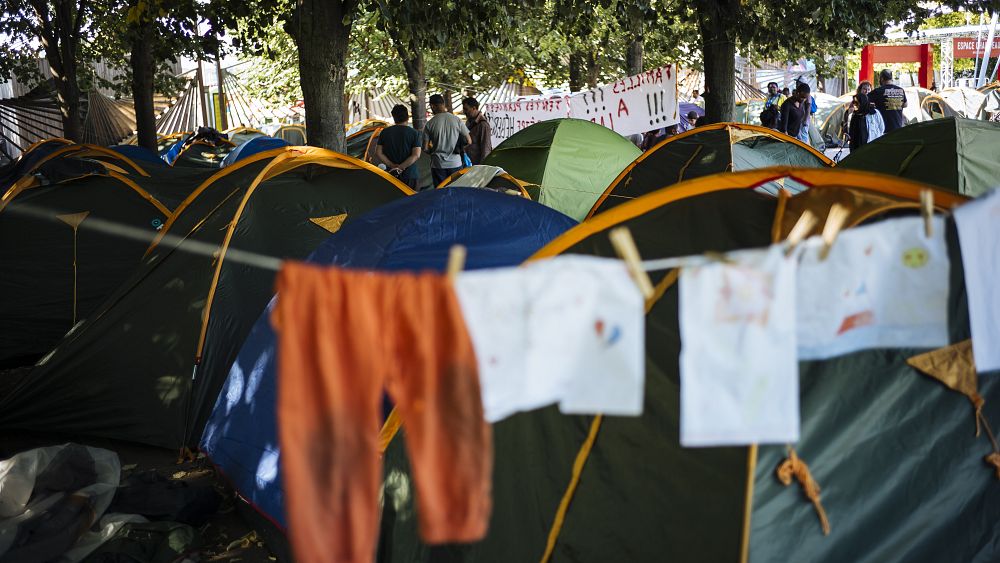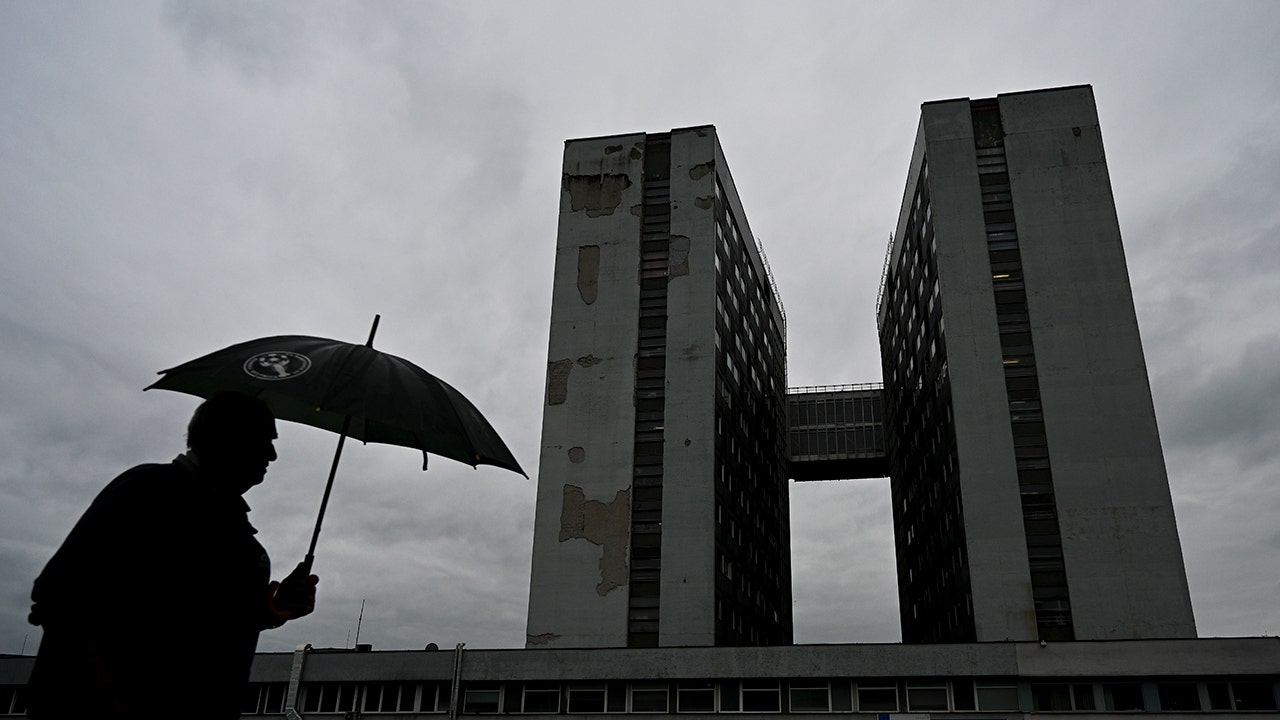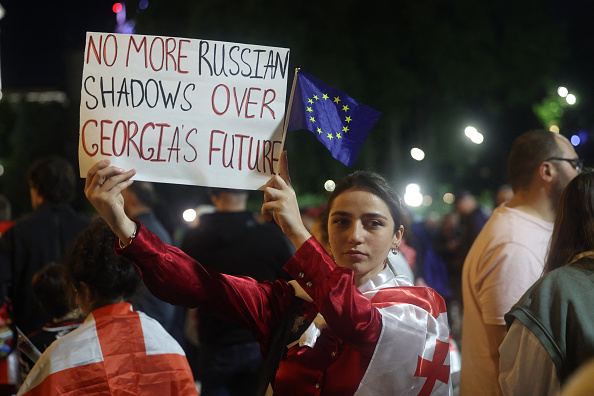World
Migrants in France can be moved out of Paris. Here’s what happens next

In May, the French government introduced a new plan to move migrants out of Paris. The idea has garnered both praise and criticism. The question is what’s happening in practice.
In the 10th arrondissement of Marseille, down a tree-lined alleyway that runs adjacent to a park, Yonatan—a Eritrean asylum seeker—sits at a white plastic table in the office of an apartment complex. He would call one of these buildings home for three weeks before being moved somewhere else. To where, he’s not sure—no one is, yet.
In May, the French government introduced a new plan to move migrants from Paris to other cities around the country. Yonatan voluntarily became part of this plan. This is one of the ten housing complexes that are used in the interim between the capital and the more long-term residential solutions.
The initiative has garnered both praise and criticism. Dispersing applications from the over-concentrated capital should free up processing times, potentially making it faster for asylum seekers and refugees to secure an official status. Cost of living also tends to be cheaper in cities outside of Paris. But some argue that the Interior Ministry’s initiative is political, and motivated by good optics ahead of the Olympics.
How this will play out in the long term is uncertain.
“Good migration policy and good integration approaches exist,” Nasar Meer, Professor of Sociology at the University of Edinburgh said. “But they’re not politically rewarding for people who want to show that they’re tough on immigrants… it requires a certain maturity and a willingness to pursue good governance… and sadly, looking across Europe at the moment, that seems quite absent.”
‘Stalingrad is common… it’s famous’
Yonatan’s journey to France began in Sudan, where he was the owner of a barbershop in Khartoum.
“It was only €2,500 for me to open one shop… four chairs… it was good,” he said.
When the country broke out into civil war, he paid €2,000 to cross the border into Libya, leaving the business behind. From there, he paid a smuggler another €2,000 to cross the Mediterranean.
“There were too many people on the boat,” he said, hands folded lightly on his lap, not breaking eye contact. “Many people died… some of them, you see it.”
Yonatan considers himself lucky that the crossing only took six days.
“We were lucky… the weather was good when I crossed,” he said. “There were 80 people, one child.”
Yonatan traveled from Italy to Nice and Marseille and then made his way north to eventually reach the makeshift migrant camp under the Stalingrad metro station in Paris.
“Stalingrad is common,” Yonaton said with a shrug. “It’s famous.”
One of the most visible examples of the housing crisis facing migrants in Paris
Stalingrad has become one of the most visible examples of the housing crisis facing migrants in Paris. Hundreds of people live in tents awaiting residency papers and the right to live and work.
Since May, buses have been coming to bring people out of the camp and into other parts of France as part of the new plan.
After arriving in the destination city, a three-week housing and evaluation period determines where they’ll be sent next, ideally a longer-term accommodation solution somewhere in that same region. The goal is to spread out some of the administrative work to regions that have a higher capacity to process it.
“People arrive by bus every three weeks… sometimes 40, 25.. it depends on the [number of] people that are ready to come, because one of the preambles and conditions that we established for this project is that people come here voluntarily,” Nicolas Hue, one of the programme’s regional directors, told Euronews. “They’re not put into buses and taken away.”
Yonatan decided to get on a bus to Marseille.
‘There are reasons why people go to Paris rather than Marseille’
“I’m happy to be here… Marseille is good, the weather and everything,” Yonatan said. He nods slowly, with a slight smile. He had been in this complex for two out of the three weeks so far. “The house is also good.”
In the mornings he takes a bus to Castellane to buy groceries. Yonatan says the programme has given him five euros worth of meal tickets per day.
In the afternoons, he walks.
“I walk the city… sometimes I start walking from here to the Gare Saint-Charles,” he said. “That’s why I like Marseille, because I see everything… I see people swimming, enjoying life… It’s good… I do only this.”
He would prefer to be working, he says, but can’t without paperwork.
If all goes according to plan, Yonatan will be moved into a regional centre at the end of the three weeks. But when asked where he’d be going, he replied that he’d return to the camp in Stalingrad, since there was a problem with his fingerprints.
Hue and Souiouf Abdou, the associate director of the temporary regional housing shelters (SAS), quickly jumped in when they heard this, insisting that there would be an exception since this was an administrative issue, and assured Yonatan that he had nothing to worry about.
Yonatan said ‘ok.’ But a couple minutes later, he said he might go back to Paris eventually to get a suitcase he left behind. Programme participants are not obligated to follow it all the way through—Yonatan can go whenever he wants.
“There are reasons why people go to Paris rather than Marseille… they may have family there, they may have friends there, they may have prior connections to that place,” Nasar Meer, Professor of Sociology at the University of Glasgow, told Euronews. “Moving people away from prior connections who can help… I don’t see how that can’t be anything but re-traumatising.”
Now, the three weeks have passed. When reached for comment, Hue did not disclose where Yonatan is now, citing confidentiality issues.
‘People who are free, who are coming to seek asylum for a better life, effectively end up locked up’
Relocating asylum seekers and refugees is not uncommon throughout the continent.
“The UK, for a long time, has had a ‘dispersal strategy,’” Meer said. “By ‘dispersal,’ they mean moving people who arrive in the southeast—London and the surrounding areas—and shuttling them around the country.”
“None of that is very good for the people who are seeking asylum… what happens is that they get locked in this awful bureaucracy… they get stuck in these processing centres which are slow and inefficient, but these places are often like prisons… so people who are free, who are coming to seek asylum for a better life, effectively end up locked up.”
But there are other examples where this has been a success.
“In Italy, for a long time, there was a very local approach in the region of Calabria where cities… got together and accommodated people in places that were historically underpopulated, or had been depopulated because people had moved to the north of Italy for economic reasons,” Meer said. “It became a place of real resettlement.”
‘House, food, papers, work… that is my dream now’
Time will tell whether this will be successful in France.
“A house and a home are not the same thing… people form meaningful homes in communities with a shared experience or history of surviving migration and trauma together,” Meer said. “That might well be the most important and valuable thing they can do, which is to keep people that can share their experiences of survival… in sufficient proximity to be able to heal.”
Yonatan aspires to work in a barbershop eventually, but has stopped hoping for anything beyond basic necessities.
“Before, when I was young, maybe I had dreams and hope…now it doesn’t exist for me,” he said. “House, food, papers, work… that is my dream now.”
The text on Yonatan’s t-shirt reads NEVER ENDING HAPPINESS.

World
Brad Pitt Spent ‘Months’ in Racecar Driver Training for His Upcoming F1 Movie

Brad Pitt has put in a lot of work to get ready for his role as a Formula 1 driver.
Jerry Bruckheimer, who serves as a producer on the highly anticipated racing film, recently opened up about Pitt’s skills behind the wheel and how the actor prepared for the still-untitled movie.
“He trained for four or five months. He’s an amazing driver,” Bruckheimer told People magazine while attending the Los Angeles premiere of Young Woman and the Sea. “In fact, some of the F1 drivers said he’s a natural athlete. He really is. He’s amazing in that car.”
Pitt is set to star in the forthcoming Joseph Kosinski-directed project as veteran F1 driver Sonny Hayes. It was previously reported that seven-time world champion Sir Lewis Hamilton would act as a consultant for the film and help the 60-year-old actor train for the high-speed sport. Speaking of which, if you’re curious about how fast Pitt has been whipping around the course, well, Bruckheimer couldn’t exactly say. “I can’t tell you. The insurance company will kill me,” he told People.
The movie itself was acquired by Apple Studios and began filming in July at last year’s British Grand Prix. Kosinski and Bruckheimer, who worked together on Top Gun: Maverick, assembled an 11th team to compete at the event. During the competition, Pitt took a spin around the Silverstone racetrack while spectators looked on. “I’m a little giddy right now, I’ve got to say,” Pitt said, speaking to Sky Sports. “I don’t know if you could call mine a hot lap, I’d call it kind of a warm lap. I’ve taken a few tours, unintentionally, through the grass.”
While the project has mostly been kept under wraps, we do know that Pitt is slated to appear alongside Damon Idris and Javier Bardem. A few key details have also emerged about the plot. “I would be a guy who raced in the 90s,” Pitt explained to Sky Sports. “He has a horrible crash and kind of craps out and disappears and then is racing in other disciplines.”
“Then his friend, played by Javier Bardem, is the team owner. They’re the last place team, they’re 21, 22 on the grid, they’ve never scored a point and they have a young phenom played by Damson Idris and he brings me in as kind of a Hail Mary and hijinks ensue,” Pitt continued.
According to Collider, the long-awaited sports drama has allegedly set a premiere date. The website reported on Thursday that the movie will hit IMAX screens on June 27, 2025, which, if it happens, would be on par with the film’s original release timeframe.
World
Slovakia's prime minister underwent another operation. He remains in serious condition

Slovak Prime Minister Robert Fico has undergone another operation two days after being shot multiple times and remains in serious condition, officials said Friday.
Fico, 59, was attacked as he was greeting supporters after a government meeting in the former coal mining town of Handlova. A suspected assailant has been arrested.
SLOVAKIA PRIME MINISTER ROBERT FICO SHOT MULTIPLE TIMES, IN ‘LIFE-THREATENING CONDITION’
Miriam Lapuníková, director of the University F. D. Roosevelt hospital in Banska Bystrica, where Fico was taken by helicopter after he was shot, said Fico underwent a CT scan and was awake and stable in an intensive care unit. She described his condition as “very serious.”
She said the surgery removed dead tissues that had remained inside Fico’s body.
“I think it will take several more days until we will definitely know the direction of the further development,” Robert Kaliniak, the defense minister and deputy prime minister, told reporters at the hospital.
A man walks with an umbrella past the F. D. Roosevelt University Hospital, where Slovak Prime Minister Robert Fico, who was shot and injured on May 15, is being treated, in Banska Bystrica, central Slovakia, Friday, May 17, 2024. Fico, 59, was shot multiple times on Wednesday as he was greeting supporters after a government meeting in the former coal mining town of Handlova. Officials at first reported that doctors were fighting for his life but after a five-hour operation described his situation as serious but stable. (AP Photo/Denes Erdos)
Still, Kaliniak stressed that the government continues to work.
“The ministries are working on all their duties, nothing is frozen or halted, the country goes on,” he told reporters. “The state is stable and today the patient is stable as well.”
Fico has long been a divisive figure in Slovakia and beyond. His return to power last year on a pro-Russia, anti-American platform led to worries among fellow European Union and NATO members that he would abandon his country’s pro-Western course, particularly on Ukraine.
World leaders have condemned the attack and offered support for Fico and Slovakia. On Friday, the Slovak press agency reported that Pope Francis has sent a letter to President Zuzana Čaputová,
“I condemn this cowardly act of violence and assure you of my prayers to the Lord for the speedy recovery and recovery of the Prime Minister,” Francis said in the letter published by the agency.
Earlier Friday, the man charged with attempting to assassinate Fico was escorted by police to his home. Local media reported that it was part of a search for evidence.
Markiza, a Slovak television station, showed footage of the suspect being taken to his home in the town of Levice on Friday morning, and reported that police had seized a computer and some documents. Police didn’t comment.
Prosecutors have told police not to publicly identify the suspect or release other details about the case. The suspect’s detention will be reviewed at a hearing Saturday at Slovakia’s Specialized Criminal Court in Pezinok, outside the capital, Bratislava.
Unconfirmed media reports suggested that he was a 71-year-old retiree who was known as an amateur poet, and may have previously worked as a security guard at a mall in the country’s southwest.
Government authorities on Thursday gave details that matched that description. They said the suspect didn’t belong to any political groups, though the attack itself was politically motivated.
Slovakia’s presidential office said Friday that it was working to organize a meeting of leaders of all parliamentary parties for Tuesday. Čaputová, the outgoing president, announced the plan together with President-elect Peter Pellegrini, who succeeds her in mid-June, in an attempt to reduce social tensions in the country.
At the start of Russia’s full-scale invasion in February 2022, Slovakia was one of Ukraine’s staunchest supporters, but Fico halted arms deliveries to Ukraine when he returned to power, his fourth time serving as prime minister.
Fico’s government has also made efforts to overhaul public broadcasting — a move critics said would give the government full control of public television and radio. That, coupled with his plans to amend the penal code to eliminate a special anti-graft prosecutor, have led opponents to worry that Fico will lead Slovakia down a more autocratic path.
Thousands of demonstrators have repeatedly rallied in the capital and around the country of 5.4 million to protest his policies.
Fico said last month on Facebook that he believed rising tensions in the country could lead to the killing of politicians, and he blamed the media for fueling tensions.
Before Fico returned to power last year, many of his political and business associates were the focus of police investigations, and dozens have been charged.
His plan to overhaul of the penal system would eliminate the office of the special prosecutor that deals with organized crime, corruption and extremism.
World
State of the Union: sunshine in Ankara, darkness in Tbilisi

This edition of State of the Union focuses on the continuing diplomatic détente between Turkey and Greece and the escalating domestic upheaval in Georgia.
Just a year ago, a summit meeting of the leaders of Turkey and Greece would have created sensational news.
But when President Recep Tayyip Erdoğan hosted Prime Minister Kyriakos Mitsotakis in Ankara this week, it was almost a routine talk between neighbours.
The meeting was their fourth in 10 months as the two leaders try to put an end to decades of mutual animosity by focusing on trade, tourism, energy and repairing cultural ties, among other areas.
“In the critical area of migration, the cooperation between our two countries and especially between the police and the coast guard is paying off against illegal flows and against the wretched traffickers, who take advantage of desperate people’s pain,” said Mitsotakis in a common press conference.
“This cooperation must continue and be intensified.”
There are still areas where both sides have agreed to disagree, but it’s good to see one old trouble spot in Europe sort of fading, especially as another trouble spot reignited big time this week.
Thousands of protesters in Georgia rallied near the parliament building in Tbilisi – again – just hours after lawmakers gave the final approval to the controversial foreign influence law, modelled on a Russian version passed more than a decade earlier.
Lawmakers passed the law despite EU warnings that it would undermine Georgia’s path to EU membership.
Yet, the official reaction in Brussels was muted.
Speaking in Denmark, EU Council President Charles Michel said: “I had a phone call a few days ago with the Prime Minister and I told him that I am disappointed and that I sincerely hope that Georgia will find a way to stick to the democratic principles and also meet the expectations of the population.”
Meanwhile, the European Bank for Reconstruction and Development released its latest economic outlook. The numbers for Georgia, which is part of the area where the EBRD operates, were rather sobering.
In general, the forecast also contained some encouraging news.
To learn more, we spoke to Beata Javorcik, chief economist of the EBRD.
Euronews: So, your latest report is appropriately called “Taming Inflation” – and when I look at the numbers, inflation in the EBRD regions came down from a peak in October 2022 of 17.5 percent to an average of 6.3 percent last March. Explain that number for us, what is behind such a huge drop?
Javorcik: What has helped bring the inflation down was to a large extent, the developments in the international markets. We have seen a sharp drop in the prices of natural gas in Europe, declines in prices of agricultural commodities, and oil prices have remained moderate. But, of course, inflation in our regions of operations still remains above the level before the pandemic, as is the case in advanced economies.
Euronews: Can you breathe a sigh of relief now or are there still important inflation risks remaining?
Javorcik: Not all central bankers can consider their job done. If you look at cumulative inflation, that is inflation since February 2022 up until now, it has exceeded 30% in several countries. Notably in Egypt, in Turkey, in Hungary and Kazakhstan, Moldova and Ukraine. So, that means that in the absence of wage increases, people in those countries would have lost a third of their purchasing power.
Euronews: Let’s talk about the growth outlook in the EBRD’s EU regions – do you see positive signs going forward?
Javorcik: This year is going to be much better than last year for the Eastern European EU member states, in particular Poland and Croatia, stand out with expected growth of 3%. Hungary will do well, too. We see real wages increasing. We see fiscal policy helping out and the EU funding, the New Generation EU, also stimulating economic activity.
Euronews: I can’t release you without a word on Ukraine. How is their economy doing in the third year of the war?
Javorcik: The heavy bombings in the last two months mean that the ability of Ukraine to generate electricity has been severely diminished. Electricity production is at 40% of what it used to be before the bombings. And this capacity cannot be easily repaired.
—-
Looking for something fun to do over the weekend?
How about jumping from a helicopter at 3,000 feet high, diving down to 35 metres above the River Thames and then soaring through London’s Tower Bridge only to rise up again to 80 metres, the height required to open the parachute before landing safely?
This is a complex James-Bond-like manoeuvre known among insiders as a “flare”.
Well, two professional skydivers from Austria did it this week and described the experience as “a dream come true”.
And this coming from veteran skydivers with more than 22,000 jumps under their belt…
From take-off to landing, the London wingsuit flight covered more than a kilometer and reached a top speed of almost 250 kilometers per hour – and it lasted 45 seconds.
That might not be enough fun for an entire weekend, but it’s a start!
-

 Politics1 week ago
Politics1 week agoRFK Jr said a worm ate part of his brain and died in his head
-

 World1 week ago
World1 week agoPentagon chief confirms US pause on weapons shipment to Israel
-

 News1 week ago
News1 week agoStudents and civil rights groups blast police response to campus protests
-

 World1 week ago
World1 week agoConvicted MEP's expense claims must be published: EU court
-

 Politics1 week ago
Politics1 week agoCalifornia Gov Gavin Newsom roasted over video promoting state's ‘record’ tourism: ‘Smoke and mirrors’
-

 Politics1 week ago
Politics1 week agoOhio AG defends letter warning 'woke' masked anti-Israel protesters they face prison time: 'We have a society'
-

 News1 week ago
News1 week agoNine Things We Learned From TikTok’s Lawsuit Against The US Government
-

 Politics1 week ago
Politics1 week agoBiden’s decision to pull Israel weapons shipment kept quiet until after Holocaust remembrance address: report



















